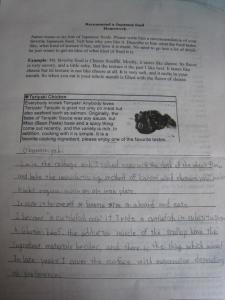Essay Time
So this week and last week I am assigning my first major bit of homework. An essay in which the students are supposed to describe their favorite japanese food, how it tastes, what the texture is, and how it is made. Most of the essays have been pretty good, however, this one is a complete mystery to me.
Here is a transcription.
Okonomiyaki
I mix the wich I ticked away the the cloth of the wheat flour and bake the manufacturing method of kansai wind okonomiyaki making kinki region main on an iron plate.
It cuts it by oneself to favorite size on a board and eats.
I become “a cuttlefish coin” if I ride a cuttlefish in substitution for pork.
A lobster, beef, the adductor muscle of the scallop have the ingredient materials besides, and the is the thing which mixed these.
In late years I cover the surface with mayonnaise depending on preference.
hmmm, guesses anyone?

The young student’s penmanship is really quite nice. The lettering is as good as the grammar is bad.
Becoming “a cuttlefish coin” sounds hurty. Do a lot of Japanese do this?
I think maybe a ‘cabbage wich’ is a sandwich made of cabbage, just like Manwich is made of man.
Thanks for making my day, young Japanese gastronome!
so he’s made okonomiyaki with pork, or possibly cuttlefish, you get extra points for cuttlefish and if you score enough cuttlefish coins you get a Chaos Emerald, but they never really did anything anyway so use beef, lobster or scallops if you feel like it. Also, mayonnaise is not for children under age 5
I think the real problem is english is all goofy
Why do we drive on a parkway and park on a driveway?
If I have a form, do I fill it out or fill it in?
Why is there no egg in eggplant, nor ham in hamburger?
If a vegetarian eats vegetables, what does a humanitarian eat?
Why does my nose run and my feet smell?
Why do people recite at a play and play at a recital?
I now fully intend to name my next Guitar Hero band “Cuttlefish Coin”
I was in a band called “Cuttlefish Coin.”
Tribute to?
Here is what I make of your student’s write-up:
One can make okonomiyaki by oneself on a hotplate, like one can make waffles by oneself at a hotel breakfast buffet. One can also cut it up to the size pieces he or she likes to eat, much as we cut up a pizza into the slice size we like. It is clear that there are different regional varieties of okonomiyaki, and this writer prefers the variety from the Kinki region. One can bake his or her own okonomiyaki with a variety of meats or fish choices in place of what must be the traditional pork. I envision customers selecting the ingredients they want from a salad bar-like array of choices before mixing and cooking their okonomiyaki with their own selection of ingredients and sauces. This reminds me of how we select ingredients and sauces at the Mongolian restaurant near Rosedale. (Have you ever eaten there?) Your writer likes to eat his okonomiyaki with mayonnaise. That suggests a little westernization of a traditional Japanese dish. With people preparing their own, it also sounds like the changing of a traditional Japanese dish into a fun fast food.
You ought to ask this student what good Kinki region okonomiyaki shops are in your area. Maybe you and Danielle could stop in at one and make an okonomiyaki meal for yourselves. Not being very adventurous, if I went, I think I would make mine the traditional pork or maybe, if I got a little more daring, lobster but not the cuttlefish.
This writer was not very careful in his essay. He made a lot of mistakes confusing similar words, and, even though I think I could figure out what he meant, these errors added to the confusion. One of your challenges in teaching, I think, is how do you encourage such students to be more careful. The other obvious problem with the write up was not selecting the correct English translation for the Japanese word he had in mind from his Japanese-English dictionary. You might want to talk in class about how to increase one’s chances of making the right word selection when there is more than one meaning. It would be interesting to know, for example, how he selected the word “coin” instead of the word he wanted.
Dad
Tribute to Phish.
Aaron,
It might be more fun to see some of the excellent essays on Japanese foods from your students.
Dad
PS
Jill, Did you mean “fish?”
Did anyone else notice the last line of the printed example above the student’s work? Please enjoy what now? I thought those were only a delicacy in Colorado….
Yeah, this is one of my more embarrasing mistakes. The second example was added by one of my JTE’s. She pasted it on my hand out and I, foolishly perhaps, went out and made all the copies for this class. Fortunately I read them after the class, and changed them for all of the other classes, but one class got the testes special.
[…] And Okonomiyaki, as mentioned previously in one of Aaron’s posts. […]